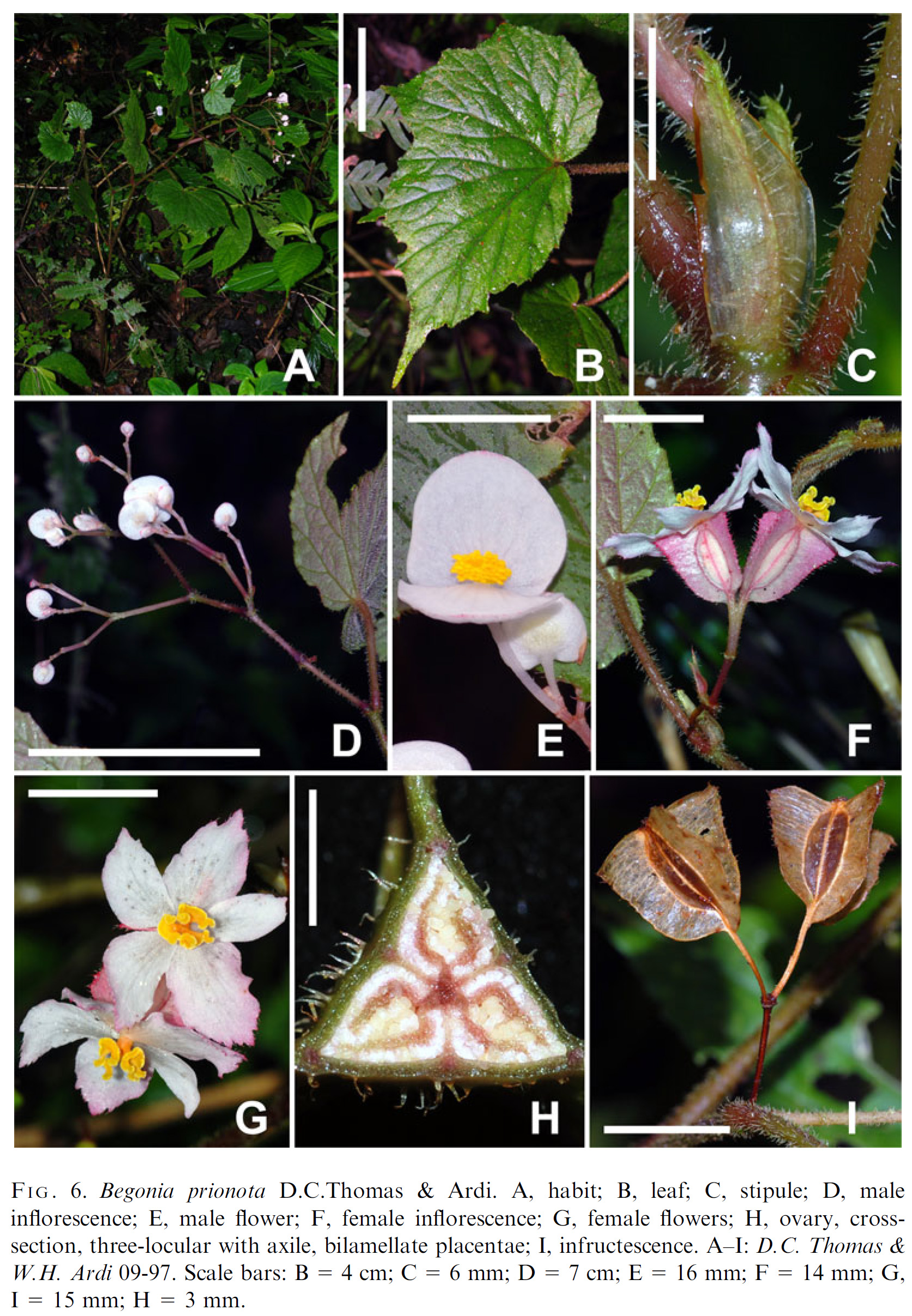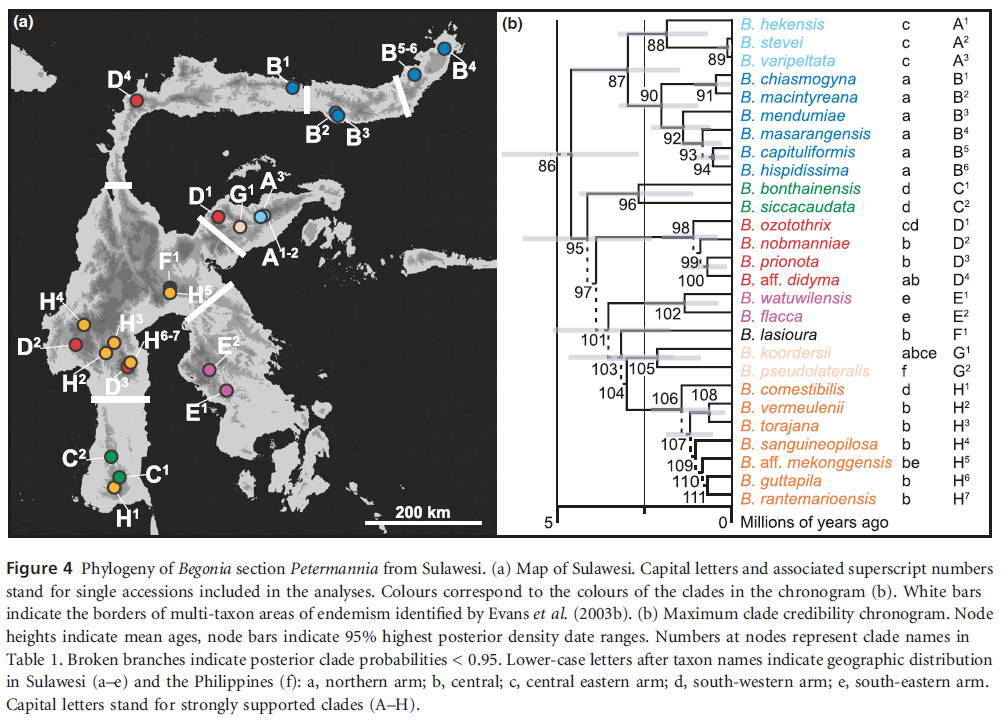Begonia prionota in Edinburgh J. Bot. 68(2): 237. 2011
Primary tabs

Diagnosis
- A ceteris speciebus celebicis tepalis florum femineorum irregulariter serratis, alis fructuum serrulatis et superinflorescentia mascula multoties ramosa cum internodiis bene evolutis et inflorescentiis partialibus monochasialibus distinguitur. - Type: Indonesia, Sulawesi, Sulawesi Selatan, Gunung Rantemario, 03°24'59.0S, 119°59'34.7E, 2175 m, 27 iv 2009, D.C. Thomas & W.H. Ardi 09-97 (holo E; iso BO, L). (Thomas, D.C., Ardi, W.H. & Hughes, M., Nine new species of Begonia (Begoniaceae) from South and West Sulawesi, Indonesia in Edinburgh Journal of Botany 68(2). 2011)
Description
- Perennial, monoecious herb with erect stems, to c.80 cm tall, with a moderately dense indumentum of multicellular, simple trichomes up to c.1.2 mm long and a sparse indumentum of microscopic, glandular trichomes on all above-ground vegetative parts.
Stems branched; internodes c.3-11 cm long, brownish-reddish.
Leaves alternate; stipules caducous, 9-15 × 3-9 mm, ovate to oblong, with an abaxially prominent midrib slightly projecting at the apex; petioles 3-10 cm long, reddish or brownish; lamina 8-15 × 4-10 cm, very asymmetric, ovate to elliptic, base cordate and lobes not overlapping, apex acuminate, margin biserrate to shallowly lobed (up to c.25% of the lamina width), irregularly scalloped, teeth long bristle-pointed, adaxial surface dark green and abaxial surface pale green, primary veins 5-6, actinodromous, secondary veins craspedodromous.
Inflorescences: protogynous; female inflorescences 2-flowered, positioned one node below the male inflorescences or solitary, peduncles c.12-20 mm long; male inflorescences distal to the female inflorescences or solitary, superinflorescence usually multiple times branched, with well-developed axes separating 2-12(-16) monochasial partial inflorescences, each with c.3-8 flowers.
Male flowers: pedicels 8-13 mm long; tepals 2, white or pinkish, 10-17 × 14-16 mm, broadly ovate, base slightly cordate, apex rounded, abaxially with a sparse indumentum of larger multicellular hairs and microscopic glandular hairs; androecium of c.47-59 stamens, yellow, filaments up to c.2.5 mm long, slightly fused at the very base, anthers up to c.1 mm long, obovate, dehiscing through unilaterally positioned slits that are > 1/2 as long as the anther.
Female flowers: pedicels 8-11 mm long; tepals 5, white with a pink tinge, unequal, smallest 8-14 × 5-7 mm, larger 12-16 × 8-13 mm, elliptic, the margin irregularly serrate from around the middle to the apex, abaxially with a sparse indumentum of microscopic glandular hairs and larger multicellular hairs; ovary ellipsoid, with a sparse indumentum of microscopic hairs and some larger multicellular hairs, locules 3, placentation axile, placentae bilamellate, wings 3, triangular, subequal, base rounded, apex truncate, the margin irregularly denticulate to serrulate, teeth extended into multicellular hairs up to c.1 mm long, style basally fused, 3-branched, each stylodium bifurcate in the stigmatic region, stigmatic surface a spirally twisted papillose band, orange.
Fruiting pedicels up to 13 mm long. Fruits ellipsoid, 14-16 × 6-7 mm (excluding the wings), sparsely to moderately densely hairy, dehiscent, splitting along the wing attachment, wing shape as for ovary, 9-11 mm wide at the widest point (at the apex); seeds ellipsoidal, c.0.3 mm long, collar cells c.1/2-2/3 of the length of the seed. (Thomas, D.C., Ardi, W.H. & Hughes, M., Nine new species of Begonia (Begoniaceae) from South and West Sulawesi, Indonesia in Edinburgh Journal of Botany 68(2). 2011)
Habitat
- This species grows in full shade on steep slopes or lithophytically on rock walls in primary rainforest between c.1300 and 2200 m above sea level. (Thomas, D.C., Ardi, W.H. & Hughes, M., Nine new species of Begonia (Begoniaceae) from South and West Sulawesi, Indonesia in Edinburgh Journal of Botany 68(2). 2011)
Conservation
- Proposed IUCN conservation category: Vulnerable (VU D2). The distribution of Begonia prionota lies just outside the western border of the Pegunungan Latimojong Protection Forest (IUCN category VI). The collections of this species are from a primary forest pocket along a small stream, where Begonia prionota grows abundantly, but the immediately surrounding area shows moderate to strong anthropogenic disturbance (logging, agriculture, settlements). No other populations of this species could be found in close proximity to the type locality or along a track leading up to the summit of Gunung Rantemario. Moreover, all available Begonia specimens from A, B, BM, BO, CEB, E, K, L, SING and WAG have been consulted. Hence it must be assumed, at least until more intensive collecting on Sulawesi reveals otherwise, that this species has a very restricted range in the Latimojong Mountains. (Thomas, D.C., Ardi, W.H. & Hughes, M., Nine new species of Begonia (Begoniaceae) from South and West Sulawesi, Indonesia in Edinburgh Journal of Botany 68(2). 2011)
Distribution
Asia-Tropical: Sulawesi (Sulawesi endemic)
Endemic to Indonesia, Sulawesi, Sulawesi Selatan.
See Images for a distribution map, and specimen tab for map of point distribution data of georeferenced specimens.
Etymology
- The specific epithet is derived from prionotos (Greek - jagged) and refers to both the serrulate wings of the ovaries and fruits and the serrulate tepals of the female flowers (see Images). (Thomas, D.C., Ardi, W.H. & Hughes, M., Nine new species of Begonia (Begoniaceae) from South and West Sulawesi, Indonesia in Edinburgh Journal of Botany 68(2). 2011)A
Notes
- Begonia prionota is a very distinct species. Diagnostic characters include the serrulate wings of the fruits, the irregularly serrate tepals of the female flowers, and the unusual architecture of the male superinflorescences, which are characterised by multiple branchings, well-developed internodes and monochasia as partial inflorescences.
Molecular Systematics
- GenBank
- see Thomas et al., 2012 (Thomas, D.C., Hughes, M., Phutthai, T., Ardi, W.H., Rajbhandary, S., Rubite, R., Twyford, A.D. & Richardson, J.E. 2012: West to east dispersal and subsequent rapid diversification of the mega-diverse genus Begonia (Begoniaceae) in the Malesian archipelago. – Journal of Biogeography 39: 98-113)
 |


